Part Three Editing / Grammar Skills
Unit 16 Nouns
Learning Objectives
- To learn different types of nouns: proper nouns, common nouns, count nouns, noncount nouns, singular nouns, and plural nouns
- To identify and understand the above types of nouns in a variety of contexts through multiple examples
- To apply different rules and uses of nouns through a variety of writing situations
I. Pretest

Adapted from myplate.gov. Last accessed on April 2, 2021.
II. Types of Nouns
Nouns are names: names of people, names of places, names of things, and names of ideas. There are different ways to classify nouns. A few usual ones are described below.
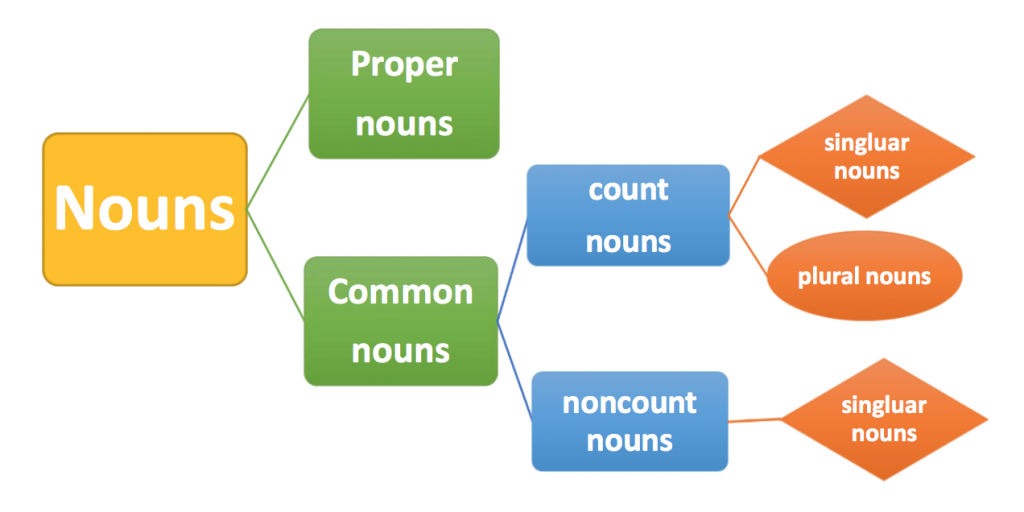
III. Proper Nouns and Common Nouns
|
Proper nouns |
Proper nouns are usually specific names of people, places, organizations, and others. The first letters are usually capitalized. |
Abraham Lincoln, Albert Einstein, Ann, Vrej… Central America, Australia, Illinois, Chicago, Michigan Avenue, Grand Park… the United Nations, the Department of Agriculture, Harper College, Smoque BBQ, Jewel Osco… |
|---|---|---|
|
Common nouns |
Common nouns are general names. The first letters are usually not capitalized. |
president, scientist, friends, professors… restaurants, organization, office, city, colleges, stores… computer, classes, safety… |
Proper nouns (bold-faced) and common nouns (underlined) are often used in the same sentences.
- Gogi and Smoque BBQ are two of the most famous restaurants in Chicago. (https://guide.michelin.com/en/restaurants)
- Harper College offers Culinary Arts Certificate to students interested in becoming cooks or chef’s assistants.
- There are many grocery stores in my neighborhood such as Jewel Osco and Whole Foods.
- The United States government has published Dietary Guidelines for Americans (DGA), 2020-2025. This document provides many guidelines for a healthy diet.
Exercise 1. Read each sentence carefully and identity the types of nouns used in each. The first one is an example.
Example:
Two United States government agencies, the Secretaries of Agriculture and Health and Human Services, publish the Dietary Guidelines for Americans every five years.
Proper nouns: United States, Secretaries of Agriculture, Health and Human Services, Dietary Guidelines for Americans
Common nouns: government, agencies, recommendations, years
- The Guidelines provide advice on what to eat more and what to eat less in order to stay healthy.
- The Dietary Guidelines for Americans, 2020-2025 offers recommendations for each life stage, from birth through older adulthood
- There are three key principles: choose mainly from the food with high nutrition, select a variety of choices from each of the five food groups, and pay attention to the portion size.
- It is never too early or too late to improve dietary choices for a healthy lifestyle.
Adapted from “Make Every Bite Count with the Dietary Guidelines for Americans”.
https://www.dietaryguidelines.gov/sites/default/files/2020-12/DGA_2020-2025_Infographic_MakeEveryBiteCount.pdf . Last accessed on September 27, 2021.
IV. Singular Nouns and Plural Nouns
|
Singular nouns |
Singular nouns refer to one person, one place, one thing, one idea… |
one egg, one meal, one supermarket, one computer, one store, one office… an egg, an office, a meal, a supermarket, a computer, a store… |
|---|---|---|
|
Plural nouns |
Plural nouns refer to two or more people, places, things, ideas .. |
two eggs, three offices, four meals, five supermarkets, several computers, many stores… |
Singular nouns (underlined) and plural nouns (bold-faced) are often used in the same sentences.
- One egg contains many nutrients.
- Most people eat three meals a day, with a snack in between.
- There are many stores in my neighborhood. Some sell computers, and some sell groceries.
Most count nouns follow fixed patterns in forming their plural forms, but some are irregular.
|
From singular nouns to plural nouns |
Examples |
|---|---|
|
For most singular nouns, add “s”. |
apple – apples, cucumber – cucumbers, grape – grapes…
|
|
For nouns ending in “ch, sh, x,-s, -ss, z”, add “es”. |
glass – glasses, dish – dishes, brush – brushes, church – churches, bus – buses, box – boxes… |
|
Exceptions: quiz – quizzes, ox – oxen |
|
|
For nouns ending in “vowel + y”, add “s”. (Vowels are a, e, i, o, u.) |
day – days, key – keys, boy – boys, toy – toys… |
|
For nouns ending in “consonant + y”, delete “y” and add “ies”. |
family – families, lady – ladies, butterfly – butterflies, strawberry – strawberries… |
|
For nouns ending in “vowel + o”, add “s”. |
radio – radios, video – videos, zoo – zoos… |
|
For nouns ending in “consonant + o”, add “es”.
|
hero – heroes, potato – potatoes, tomato – tomatoes… |
|
Exceptions: piano – pianos, auto – autos, photo – photos … |
|
|
For nouns ending in “f” or “fe”, delete “f” or “fe” and add “ves”:
|
leaf – leaves, life – lives, knife – knives, shelf – shelves, half – halves, loaf – loaves, wife – wives, wolf – wolves… |
|
Exceptions: chef – chefs, cliff – cliffs, sheriff – sheriffs, roof – roofs, belief – beliefs… |
|
|
For some nouns, their plural forms are irregular: |
man – men, woman – women, child – children, person – people (more common than “persons”), foot – feet, tooth – teeth, goose – geese, mouse – mice, crisis – crises, analysis – analyses… |
|
Some nouns usually remain singular for both singular and plural forms. |
sheep – sheep, deer – deer, moose -moose, fish – fish, shrimp – shrimp…
|
|
Some nouns always appear in plural forms. |
glasses, scissors, jeans, pants, pajamas, shorts… |
Exercise 2. Choose the singular or plural forms of the nouns to finish the following paragraph about the Dietary Guidelines. Type your choices in the boxes. You will receive instant feedback. When you finish the entire exercise you may retry or see all the answers.

Example:
There are many __________ (idea, ideas) to keep us healthy in the Dietary Guidelines for Americans.
V. Count and Noncount Nouns
|
Count nouns |
When people or things can be counted by 1, 2, 3…, they are usually count nouns. If there are more than one, use the plural form.
|
one brother, two sisters … one pound, two cups, three eggs … |
|---|---|---|
|
Noncount nouns |
Some things cannot be counted or are too small to be counted. They are usually noncount nouns. Noncount nouns are always singular.
|
water, coffee, snow, rice, sand, salt … English, math, biology … danger, love, anger …
|
Count nouns (underlined) and noncount nouns (bold-faced) are often used in the same sentences or groups of sentences.
- My meal often includes rice, some vegetables, and some seafood.
- In our nutrition class, we are discussing the five food groups. We are surprised that a cup of 100% fruit juice is considered a serving of fruit.
- Many people read the Nutrition Facts label when they buy food. The label tells them a lot of useful information.
- Overweight and obesity can cause many diseases.
Exercise 3. There is one error in the use of count or noncount noun in each of the following sentences about the Nutrition Facts labels. Find the error and correct it.
Example:
There is a lot of advices (advice) on leading a healthy life.
- The Nutrition Facts label tells consumers a lot of informations about the food they are buying.
- It lists how many servings there are in the package, how many calories each serving has, and how many gram of nutrients each serving contains.
- In the label for frozen lasagna below, there are four serving in the package, and each serving equals 1 cup, with 280 calories.
- Knowing how many servings we are eating is important. If we have 2 servings of lasagna for dinner, we will eat 2 cup, with 560 calories and 18 grams of fat!
- We should always remember to add vegetables to the dinner plate: tomatoes, peppers, corns, and others.
- Eating healthy seems like a lot of works, but it is worth our time and efforts.

VI. Rules in Using Nouns
1. Do not put “a/an” or a number (one, two…) in front of a noncount noun. Do not add an “s” to the end of it.
- The restaurant has installed
three new equipments: a big-screen TV and two deep freezers. - The restaurant has installed some new equipment: a big-screen TV and two deep freezers.
- The restaurant has installed three pieces of new equipment: a big-screen TV and two deep freezers.
- Each customer will receive a free dessert: a large strawberry dipped in
a chocolate. - Each customer will receive a free dessert: a large strawberry dipped in chocolate.
2. Do not put “a/an” in front of a count noun and add an “s” after it at the same time.
- Many children eat
an applesevery day. - Many children eat an apple every day.
- Many children eat apples every day.
3. Singular count nouns usually cannot stand alone. They need some kind of “determiners” in front of them. These “determiners” include articles (a, an, the), numbers (one, two…), possessive adjectives (my, his, your…), or demonstrative adjectives (this, that).
- I eat
appleevery day. - I eat an apple every day.
- I eat one apple every day.
- Please join
discussionon healthy living next Monday. - Please join our discussion on healthy living next Monday.
- Please join the discussion on healthy living next Monday.
Labelshows how much fat one serving of lasagna has.- This label shows how much fat one serving of lasagna has.
4. Use the singular form of the verb with a singular count noun. Use the plural form of the verb with a plural count noun. Use the singular form of the verb with a noncount noun. The pronouns also change accordingly.
- A medium tomato has about twenty-two calories and one gram of protein. It does not contain any cholesterol.
- Fresh tomatoes are on sale in the supermarket near my home. They taste great.
- There are two slices of bread in my lunch box. I will use them to make a sandwich.
- My sandwich is delicious and healthy. It contains two slices of whole wheat bread, two pieces of iceberg lettuce, a slice of low-fat shedder cheese, and a piece of grilled chicken breast.
For more explanations and examples of subject-verb agreement, please refer to Unit 10. Open Unit 10 here.
For more explanations and examples of noun-pronoun agreement, please refer to Unit 19. Open Unit 17 here.
5. In the phrase “one of ________”, use a plural noun, but use the singular form of the verb because the subject is “one”.
- According to the Dietary Guidelines for Americans, 2020-2025, one of the daily goals is to have 85% of our calories from nutrient-dense[1] foods and beverages[2].
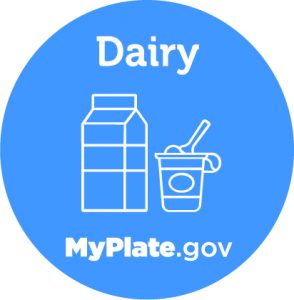
MyPlate.gov dairy logo - One of the five food groups contains dairy. For children two to three years old, dairy is especially important.
- One of the nutrients from dairy is calcium. It helps children build stronger bones.
6. Some nouns are used in the singular form even though they imply plural meaning. This is because they act like adjectives. Adjectives in English are always singular.
- Nutrition 101, also called Fundamentals of Nutrition, carries 3 credit hours at Harper College. It is a 3-credit-hour course.
- It is interesting to notice that anyone 9 years or older should take the same amount of dairy: 3 cups a day. This means that 9-year-old boys or girls should not take in more diary than 40-year-old men or women.
- It seems that the daily dairy needs are the same for a growing 12-year- old boy and a mature 60-year-old man.
Adapted from https://www.myplate.gov/eat-healthy/dairy. Last accessed on September 27, 2021.
7. Use the singular form of a count noun after “each” and “every”.
- Each glass is filled with juice for children and wine for adults.
- Every guest is having a fun time.
Exercise 4. There is one error in the use of noun or its “determiner” in each of the following sentences about healthy eating. Correct the noun or its determiner. Do not change anything else in the sentence.
Example:
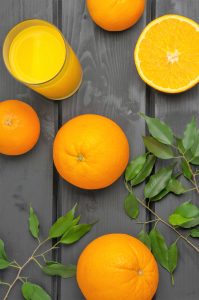
If we are concerned about our weight, drinking skim milk instead of whole milk might help us lose an extra pounds. (extra pounds or an extra pound)
- Although juice is a convenient source of vitamin, it is low in fiber.
- It is better to have whole orange than a cup of orange juice.
- One of the problem in the modern diet is having too much sodium.
- When we eat cooked bean from a can, we should dump[3] the sauce in the can and rinse the beans with water before eating them. That way, we will take in less sodium.
- A five-courses meal may look delicious, but it almost always has too much fat, cholesterol, and sodium contents.
- A two-years-old child should eat about three ounces of grains every day. A child nine years old should eat about five ounces.
- If the children are nine year old, they should eat about five ounces of grains every day.
- We should not forget to drink a water every day.
- One of the best way for us to stay healthy is to watch what we eat and drink daily.
- At last night’s party, the hosts[4] made sure that every dishes was hot and decorated with garnish[5] made of vegetables.
Some information adapted from https://www.myplate.gov/myplate-plan/results/1000-calories-ages-2-3
and https://www.myplate.gov/your-myplate-plan-1400-calories-ages-9-13.
Last accessed on September 27, 2021.
VII. Unit Review Practice
Exercise 5. You may often hear sayings about food. Choose a saying below and free write for five minutes whether or not you agree and why you think so. The authors’ names are included in the parentheses. If you are interested in them, you can search for their information online later.
- Life is uncertain[6]. Eat dessert first. (Ernestine Ulmer)
- The secret of success in life is to eat what you like and let the food fight it out inside. (Mark Twain)
- All happiness depends on a leisurely[7] breakfast. (John Gunther)
- One cannot think well, love well, sleep well, if one has not dined[8] well.
(Virginia Woolf, A Room of One’s Own) - There is no love sincerer than the love of food. (George Bernard Shaw, Man and Superman)
- One must eat to live, not live to eat. (Jean-Baptiste Poquelin)
- Take care of your body. It’s the only place you have to live. (Jim Rohn)
Exercise 6. The following paragraph is about nutrition needs of vegetarians[9]. In the underlined nouns, find twelve more errors (not including the example). Correct the errors. The first one is an example.
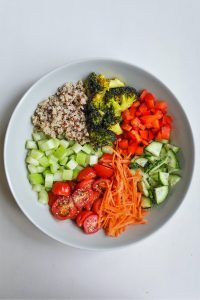
Nutrients for Vegetarians
The American Academy of Nutrition and Dietetics advises vegetarians to meet the daily needs of five important nutrient (nutrients). They are calcium, iron, protein, Vitamin B12, and Vitamin D. If some vegetarians do not eat dairy product, they should get their calciums from plant-based foods such as tofu and almond milk. Iron is another essential nutrients, and vegetarians should get it from dark, leafy vegetables like spinaches and chard. One of the iron source is fortified breakfast cereals. For example, a cup of multigrain cheerios provides about 75% daily value of iron. Since vegetarians do not eat meat, protein can be taken from beans, nut, and whole grains. For those who do not eat egg or dairy products, a Vitamin B12 supplements is recommended. Fortified cereals are also a convenient and inexpensive sources. The same cup of multigrain cheerios contains about 75% daily value of Vitamin B12. Another essential nutrients is Vitamin D. Not many foods naturally contain Vitamin D, so it is important for vegetarian who do not eat dairy products to get adequate sunlights or take a Vitamin D supplement.
Adapted from https://www.eatright.org/food/nutrition/vegetarian-and-special-diets/food-sources-of-important-nutrients-for-vegetarians. Last accessed on September 28, 2021.
Exercises 7. In the following paragraph about my grandmother and me, there are twelve more errors in the use of nouns (not including the example). Find the errors and correct them. The first one is an example.
With My Grandma in the Kitchen
Learning to cook from my grandmother remains one of the sweetest memories in my life. She taught me how to cook while I was living with her during my high school years. At that time, she was in her 60s and had been preparing meals for the family for decades. One of my favorite dish (dishes) to make was broccoli apple salad. She would get fresh ingredient from a local grocery stores in the morning, and we would make the salad in the afternoon after I came back from school. There was not a lot of homeworks then, so I was able to enjoy my times with my grandma in the kitchen. (four more errors in this paragraph)
When I got home, she had already laid all the ingredients on the kitchen table: a pound of broccoli, two apple, a small onions… We would wash every apple and every broccoli florets. I even rinsed[10] each walnut piece and every raisins under water as well. The fun part was to make the sauce by mixing mayonnaise, lemon juice, salt, and sugar. (four errors in this paragraph)
My grandma would add each ingredients a little at a time to make sure all was mixed perfectly. However, I did not have the patiences, and I was usually hungry by then. I would use a huge spoons to shovel sugar and salt into the mix, which usually turned out to be either too sweet or too salty[11]. This often led to a loving scolding from my grandma, but I knew that she loved me and would never get upset with me. Many year have passed, but my memories with my grandma in the kitchen have always been dear to my heart. (four errors in this paragraph)
Exercise 8. Read the following recipe. There are ten more errors in the use of nouns (not including the example). Find the errors and correct them.
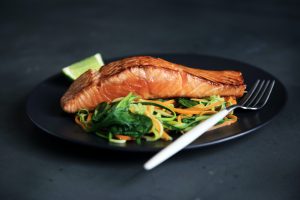
Baked Soy Ginger Salmon
A plate of baked soy ginger salmon is a weekly fixture[12] on my family’s dinner table. It is very easy to make when I follow the following step (steps). The first step is to get all the ingredient ready. I need one pounds of salmon fillet and one teaspoon of each: seasoned salt, cooking wines, and vegetable oil. Besides, I prepare two teaspoon of low sodium soy sauce, half a teaspoon of sugars, and half a cup of water. There are two more dry ingredients: some thin slice of ginger roots and green onions for flavor. When everything is ready, sprinkle seasoned salt over the salmon fillet and keep it refrigerated for 30 minute. Mix the remaining ingredients in a bowl. At the same time, preheat the oven to 350 degree Fahrenheit. Line a tray with a piece of aluminum foil. The aluminum foil is essential because I will not need to scrub the stains off the tray later. As soon as the oven reaches the desired temperature, place the marinated fillet in the center of the tray and pour the rest of the ingredients over the fillet. Put the tray in the center rack of the oven and bake for 20 to 25 minutes. Put the baked fillet on a plate, garnish with some colorful vegetable. An easy-to-make dishes is created for my family to enjoy!
Exercise 9. Click the weblink below to open “Dietary Guidelines for Americans, 2020-2025”. Follow the instructions below.
- Turn to page i and ii (Table of Contents) to choose a topic you are interested in. Then go to the given page(s) for that topic.
- Read the information there and highlight all the nouns.
- Free write for five minutes what you have learned from the information on the page you have just read. What is the information? Is it new to you? How will it impact your diet?
- Exchange your work to share ideas with your partner.
Exercise 10. Look for a recipe in the weblink below. Examine the ingredients and the amount of each ingredient. Then look at the Nutrition information and MyPlate Food Groups below the recipe.
Write a review of this recipe. In what ways do you like or dislike about it? You can submit your review right there on the website.
Exercise 11. Discuss or write a paragraph for each of the following topics.
- What is your favorite food from your native country? What food group does it belong to? Why is it your favorite? Is it available in stores in the U.S.? Share a picture and a recipe if possible.
- Choose two food items that you eat on a regular basis. Search for their Nutrition Facts labels online (for example, google.com). Discuss the serving size, number of servings, number of calories, grams of fat, etc. Then discuss whether or not these items contribute to a healthy diet.
NSNT Practice

Go to The NSNT Free Writing Approach and Additional Weekly Prompts for Writing in Appendix A. (Open Appendix A here.) Choose two topics that you have not written about. You may start with the NSNT approach. Then revise and edit your paragraphs. Pay attention to the use of nouns. You are encouraged to share your writing with your partner and help each other improve.
Vocabulary Review

The words here have appeared in this unit. The best way to learn them is to guess the meaning of each word from the context. Then hover your computer mouse over the number beside each word to check its meaning and part of speech. These words are also listed in the footnote area at the end of each unit.
Here, you can use the flashcards below to review these words.
Summary
- Nouns are names of people, places, things, ideas, etc. There are different types of nouns.
- Proper nouns are specific names of people, places, and organizations. Common nouns are general names.
- Count nouns are in their singular forms when referring to one and in their plural forms when referring to two or more. Noncount nouns are always singular.
- The following uses about nouns are important:
- Do not put “a/an” or a number (one, two…) in front of a noncount noun. Do not add an “s” to the end of it.
- Do not put “a/an” in front of a count noun and add an “s” after it at the same time.
- Singular count nouns usually cannot stand alone. They need a “determiner” in front of them, such as articles (a, an, the), numbers (one, two…), possessive adjectives (my, his, your…), or demonstrative adjectives (this, that).
- Singular nouns are followed by the singular forms of verbs and pronouns. Plural nouns are followed by the plural forms of verbs and pronouns.
- In the phrase “one of ________”, use a plural noun, but use the singular form of the verb.
- Some nouns like the word “year” in “a ten-year-old boy” are used in the singular form when they are part of an adjective.
- Use the singular form of a count noun after “each” and “every”.
Media Attributions
- U.S. government new food plate icon © U.S. Depart of Agriculture
- types of nouns © Lin Cui is licensed under a CC0 (Creative Commons Zero) license
- cover of Dietary Guidelines for Americans, 2020-2025 © United States Department of Agriculture
- nutrition facts label for frozen lasagna © United States Food and Drug Administration
- MyPlate.gov dairy logo © United States Department of Agriculture is licensed under a Public Domain license
- some oranges and a glass of juice © Photo by aliet kitchen on Unsplash
- a plate of vegetables © Photo by Polina Tankilevitch from Pexels
- a plate of salmon fillet with vegetables © Photo by Caroline Attwood on Unsplash
- a pen writing in a notebook © Photo by Aaron Burden on Unsplash
- a page in a dictionary © Pixabay
- nutrition-dense: adjective, full of nutrients ↵
- beverage: noun, a drink ↵
- dump: verb, drop, empty out ↵
- host: noun, a person who receives and entertains guests in his home ↵
- garnish: noun, food or drink decoration to increase flavor, color, etc. ↵
- uncertain: adjective, unsure ↵
- leisurely: adjective, relaxing ↵
- dine: verb, eat ↵
- vegetarian: noun, a person who eats only vegetables ↵
- rinse: verb, wash lightly by pouring water over something ↵
- salty: adjective, containing too much salt ↵
- fixture: noun, something that is fixed in a place ↵

